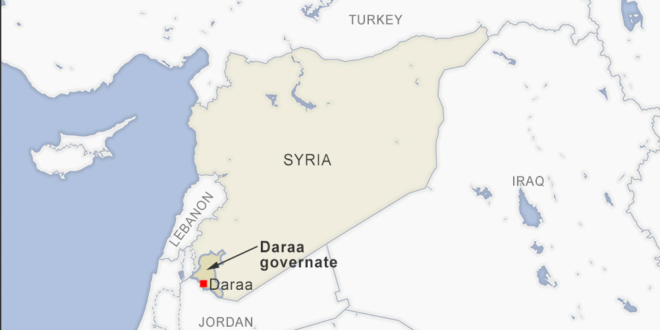Despite the heavy presence of Syrian and Russian forces in southern Syria, militants affiliated with the Islamic State group appear to be active in the region.
Last week, local fighters, some of whom were affiliated with the Syrian government, carried out an operation targeting several hideouts belonging to IS operatives in a town in the southern province of Daraa. During the raid, at least six IS members were killed, and three houses used as IS operations centers were destroyed, according to local news reports.
The multi-day operation, which ended Sunday, seemed to be in response to an October 13 bombing of a military bus in the Syrian capital of Damascus that killed at least 18 Syrian soldiers.
Russia, a strong backer of the Syrian government, has accused IS cells in Daraa of carrying out the attack.
The Syrian Observatory for Human Rights told VOA it couldn’t confirm whether the individuals targeted in Daraa were responsible for orchestrating the Damascus bombing.
“But what is certain is that those killed in the town of Jasim [in Daraa] were Syrian and Iraqi nationals that were indeed members of Daesh,” said Rami Abdulrahman, director of the U.K.-based observatory, using an Arabic acronym for the terror group.
A media activist in Daraa who requested anonymity for safety reasons told VOA that one of the IS operatives killed during the clashes last week was a high-profile leader responsible for assassinating several former opposition figures in southern Syria.
Occasional attacks
Since 2018, when Syrian government forces and allied militias recaptured the region from rebel forces, Daraa and surrounding areas have seen occasional attacks claimed by IS militants and other extremist groups.
Sadradeen Kinno, a Syria researcher who closely follows militant groups in the war-torn country, said the Syrian regime and its Russian allies have not cleared the south of all radical groups, including IS.
“The security situation in Daraa and other southern parts of the country remains fragile because the Syrian regime’s ability to provide post-IS stability is different from that of other players that have fought Daesh, such as the [U.S.-backed] Syrian Democratic Forces in northeast Syria,” he told VOA.
For one, Kinno said, the regime’s military units in every part of Syria fall under different foreign commands, including Russia and Iran.
“The units that are affiliated with Russia in the south have in recent months proven to be ineffective and disorganized, largely because Russia has been focused on its war in Ukraine,” he said, adding that IS cells “have naturally exploited the situation to increase their presence in the south.”
The Syrian regime is currently not capable of pushing back IS operatives in areas that are entirely under its control, Kinno said.
Other experts said the Syrian government could have tolerated the presence of some elements of IS to threaten the remaining rebel groups that have not reconciled with the government.
As part of a Russian-brokered deal in 2018, the Syrian government allowed several rebel groups to remain in Daraa if they agreed to lay down their arms or fight under the regime’s command. Some groups, however, kept their arms without fighting alongside government forces.
“The Syrian regime’s narrative is that all fundamentalist groups in the south have been arrested since 2018, but we keep hearing about the emergence of Daesh cells in towns across Daraa,” said Hisham al-Masalmeh, a Belgium-based Syrian political analyst who hails from Daraa.
“Every town in southern Syria is controlled by dozens of checkpoints, so it’s questionable as to how these Daesh cells were able to infiltrate into any town in the area,” he told VOA.
“It’s clear that the regime tries to use them against local rebel groups.”
 Eurasia Press & News
Eurasia Press & News




